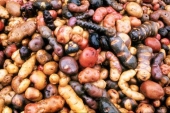Quite a lot, really. The observation that climate zones are
moving should be enough to convince people who don't "believe" in climate change, but sadly that is not the case. The closer you work with the land, the more up close and personal drought and heat waves and unusual weather events are, and the more you ought to accept what scientists are telling us. The Intergovernmental Panel on Climate Change (IPCC) is out with their fifth assessment report today, which is an update from their last scholarly pronouncement in 2007. It predicts even faster warming and sea level rise for the remainder of the century.
But while the IPCC looks at all the worldwide macro data on climate, their report doesn't contain much of practical import for the Permie who wants to make their own piece of dirt food secure and sustainable. I thought I would start this thread so we can exchange some ideas on how climate change has affected our gardens personally. There are two effects that I have noticed, one good and one not-so-good.
The good change for me is that I am now in climate zone 9. The link above still has my corner of Georgia in zone 8, but that is just the change from 1990 to 2006. In the intervening 7 years, it seems like zone 9 has crept further north. I'm still planning on putting up my seasonal greenhouse this fall; I don't want to take any chances with my citrus trees, especially since this is the first year my blood orange tree has fruit on it. Maybe in another 10 years, we will be in zone 10 and I can forget all about having to put up a greenhouse.
The not-so-good change has been in the variability of precipitation. Anyone who doubts that we have transitioned to a new pattern of droughts punctuated by much heavier downpours is just not paying attention. This year was a horrible year for corn and squash and tomatoes because of too much rain. Even having mine on top of hugelbeds didn't save them. But there was one bright spot in the garden. I had grown some taro plants last year, just on a whim, so there were taro tubers that overwintered in the soil. While everything else was drowning in too much rain back in July, my taro plants were growing like weeds! Which brings me to a climate change recommendation that Permies should incorporate as standard practice:
Climate Change Rule #1: Intercrop a drought crop with a flood crop. As an example, intercrop taro with tomatoes. If it's hot and dry, tomatoes will do well; if it rains every day for three weeks, you won't have tomatoes, but you will have a bumper crop of taro. Anyone think of any other examples?
Something else that has taken off this year are my kiwi vines. I don't know if I should chalk it up to the wet weather or to my mulching them extra heavy last winter. But this year they have finally decided to grow on my patch of heavy Georgia clay. Maybe next year I will get my first fruits from them!
Another thing I have noticed from applying permaculture principles over the last four years since I got this place: there are a lot more critters co-habitating with me now. Skinks, toads, turtles, spiders, millipedes, more toads, salamanders, a big black snake, rabbits, frogs, and did I mention -- toads. I also seem to have less bug problems this year. Must be all the toads chowing down on any squash bug or harlequin bug or grasshopper that dares to invade. Which brings me to another rule
Climate Change Rule #2: Biodiversity is your friend. If species are having a tough time adjusting to the new climate, invite them to stay on your piece of dirt and they will reward you in untold ways. Even go out of your way to move an orb web spider egg sac to a more protected location and the following spring you will have hundreds of little buggers snagging the invading insect armies.
Climate change is going to force a lot of adaptation over the coming decades. Permies are going to have an advantage over conventional agriculture because we already adapt to nature. We're just going to have to be more observant to know what new things to adapt to.

 2
2








 1
1




 1
1




![Filename: green_hubbard.jpg
Description: [Thumbnail for green_hubbard.jpg]](/t/28504/a/11639/green_hubbard.jpg)
 1
1




 1
1
























